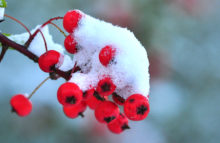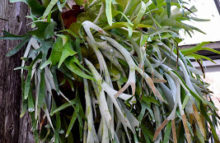As the days started to shorten a couple of weeks ago I went to Home Depot to get some little household hardware-y style item, something light-bulby I think it was.
I can never go there without making a stop in their massive garden supply area. Their outdoor section was rolled up for the season, but their huge greenhouse was brimming with goodness. While plants at this store are unfortunately never going to get TLC from their employees, they do get new stock often, so a visit usually provides a bounty of cheap and plentiful seasonal pickings.
 I bought a beautiful lime green Phalenopsis orchid there last year that bloomed for 3 months, during winter’s bleakness. You can see it here peeking out behind my laptop. It was the second orchid I’ve purchased, and I expected it, like the first one, to die in due course. Orchids, according to conventionial wisdom, are difficult and temperamental. My orchid remained green, yet by spring it did look a little….careworn. What to do? After a quick trip around the Google, one thing I did after flowering, was to cut back the flowering stem to half-way. A second flowering was supposed to happen, somehow, in some fashion. I did as instructed and hoped for the best.
I bought a beautiful lime green Phalenopsis orchid there last year that bloomed for 3 months, during winter’s bleakness. You can see it here peeking out behind my laptop. It was the second orchid I’ve purchased, and I expected it, like the first one, to die in due course. Orchids, according to conventionial wisdom, are difficult and temperamental. My orchid remained green, yet by spring it did look a little….careworn. What to do? After a quick trip around the Google, one thing I did after flowering, was to cut back the flowering stem to half-way. A second flowering was supposed to happen, somehow, in some fashion. I did as instructed and hoped for the best.
I take my houseplants outside for a summer vacation, and the orchid went out too. I figured it would languish for a while and then give up the ghost. It wasn’t looking too happy in the springtime. Let’s face it, when out of bloom, orchid leaves are floppy, leathery and none too decorative. I did manage to keep it watered over the summer, and remembered to feed it a couple of times. It was in the shade under my balcony canopy, and got bright light.
As the summer turned to fall, the leaves started to pick up, got greener and more sturdy looking. You can see the new fleshy roots it formed in the fall, in the picture above. It was clear that this orchid was going to make it. The cut-back flower stem however, continued to look like a dead stick, and had all the aesthetic properties of…a dead stick. But I left it and continued to hope.
A couple of weeks passed and the dead stick began to look greener and fleshier. A node began to swell. I watched with interest. As days went by the swelling node morphed into the beginnings of a leaf, then another, then aerial roots started to grow and reach outwards and downwards. Growth began faster and faster. I brought the plant indoors as the weather was getting colder, and the new plant kept developing. I discovered that this new plant on the stem is called a keiki and it’s the typical way that Phalenopsis orchids are propagated, and, of course, how they multiply in their natural surroundings.

As it was getting comparatively huge by this point, after some more research from Google, I severed the keiki from the stem and potted it up in a new small clay pot. The way you do this is to leave a little piece of the flower stem attached on both sides of the keiki so as not to disturb it.
Oh, forgot to mention the most important part! This keiki also had a new flower stem growing as well. The main plant also had a new flower stem growing at the base of the old flower stem (AKA dead stick). Hurrah! I did worry that performing this surgery when both mother and child had new babies in the works would mess things up for one or both of them, but I bit the bullet.
A couple of weeks after surgery, mother and baby are doing well, and both still have their flower buds. These “buds” simply look like little green stems growing at a 45 degree angle at the moment, but I have hope that the nodes will swell and orchid flowers will appear. Yes they can!
How proud am I to be simply NOT a killer of orchids, but rather a propagator of them. Of course another trip around the Google lets me know that Phalenopsis orchids are the “easiest” orchids. And it’s true. So don’t be scared of picking one up the next time a beauty starts winking at you at the Home Depot!






3 comments
Hi, I wonder if you can help. I just bought two "keikis" of the Phalenopsis orchid from Penang, Malaysia – instruction says just plant in charcoal. I used sphagnum moss and a little charcoal and have placed the two little keikis. Is this the correct way to grow them? THere's no change since the last two weeks, so I'm worried. Should I use bark or some other material too? Thanks for any suggestions.
Gururaj (gururajr@jcom.home.ne.jp)
Hi Gurauraj,
I planted mine in a mix of soil, bark. I think charcoal is a good idea too.
As long as the mix has some "airiness" which is provided by the bark and spaghnum moss I think they are happy.
Keep them well misted after you transplant to get them over the hump. You can put them on a tray of pebbles with water so the humidity is increased too.
Put them in a bright location with no direct sun.
Good luck with your keikis. Mine still have flower shoots but have yet to bloom. I keep hoping.
Thanks so much, Sarah. I'll try adding some fine bark to the potting mix too.